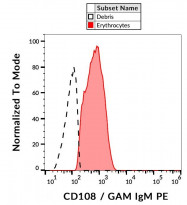ARG62704
anti-CD108 antibody [MEM-150]
anti-CD108 antibody [MEM-150] for Flow cytometry,Immunoprecipitation,Western blot and Human
Cell Biology and Cellular Response antibody; Immune System antibody; Neuroscience antibody
概述
| 产品描述 | Mouse Monoclonal antibody [MEM-150] recognizes CD108 |
|---|---|
| 反应物种 | Hu |
| 应用 | FACS, IP, WB |
| 特异性 | The clone MEM-150 reacts with CD108 (JMH blood group antigen), a 80 kDa GPI-anchored glycoprotein expressed on various cell types including erythrocytes, lymphoblasts; at low levels it is present on circulating lymphocytes. HLDA V; WS Code AS S017 HLDA V; WS Code BP BP347 HLDA VI; WS Code BP 401 HLDA VI; WS Code BP 475 HLDA VI; WS Code NL N-L156 HLDA VI; WS Code P PR-65 |
| 宿主 | Mouse |
| 克隆 | Monoclonal |
| 克隆号 | MEM-150 |
| 同位型 | IgM |
| 靶点名称 | CD108 |
| 抗原物种 | Human |
| 抗原 | HPB-ALL human T cell line |
| 偶联标记 | Un-conjugated |
| 別名 | H-Sema-L; Sema L; Semaphorin-7A; Sema K1; CDw108; SEMAK1; CD antigen CD108; CD108; John-Milton-Hargen human blood group Ag; Semaphorin-L; Semaphorin-K1; JMH; H-SEMA-K1; SEMAL; JMH blood group antigen |
应用说明
| 应用建议 |
|
||||||||
|---|---|---|---|---|---|---|---|---|---|
| 应用说明 | WB: Under non-reducing condition. * The dilutions indicate recommended starting dilutions and the optimal dilutions or concentrations should be determined by the scientist. |
属性
| 形式 | Liquid |
|---|---|
| 纯化 | Purified from ascites by precipitation methods and ion exchange chromatography. |
| 纯度 | > 95% (by SDS-PAGE) |
| 缓冲液 | TBS (pH 8.0) and 15 mM Sodium azide |
| 抗菌剂 | 15 mM Sodium azide |
| 浓度 | 1 mg/ml |
| 存放说明 | For continuous use, store undiluted antibody at 2-8°C for up to a week. For long-term storage, aliquot and store at -20°C or below. Storage in frost free freezers is not recommended. Avoid repeated freeze/thaw cycles. Suggest spin the vial prior to opening. The antibody solution should be gently mixed before use. |
| 注意事项 | For laboratory research only, not for drug, diagnostic or other use. |
生物信息
| 数据库连接 | |
|---|---|
| 基因名称 | SEMA7A |
| 全名 | semaphorin 7A, GPI membrane anchor (John Milton Hagen blood group) |
| 背景介绍 | CD108 (Sema7A) is a GPI-anchored semaphorin family member, which enhances central and peripheral axonal growth and is required for proper axon track formation during ebryogenesis. CD108 also regulates osteoclast differentiation and pre-osteoblastic cell migration, and in immune system affects cell proliferation, chemotaxis and cytokine release. On erythrocytes CD108 defines the JMH (John-Milton-Hagen) human blood group. CD108 signalizes through its receptors – plexin C1 and beta1 integrins. |
| 生物功能 | Plays an important role in integrin-mediated signaling and functions both in regulating cell migration and immune responses. Promotes formation of focal adhesion complexes, activation of the protein kinase PTK2/FAK1 and subsequent phosphorylation of MAPK1 and MAPK3. Promotes production of proinflammatory cytokines by monocytes and macrophages. Plays an important role in modulating inflammation and T-cell-mediated immune responses. Promotes axon growth in the embryonic olfactory bulb. Promotes attachment, spreading and dendrite outgrowth in melanocytes. [UniProt] |
| 研究领域 | Cell Biology and Cellular Response antibody; Immune System antibody; Neuroscience antibody |
| 预测分子量 | 75 kDa |
检测图片 (1) Click the Picture to Zoom In
克隆号文献








